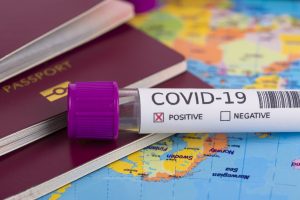Review published by Grant et al. and GrassrootsHealth to link COVID-19 and vitamin D earned highest number of citations in 2020
FOR IMMEDIATE RELEASE
Orthomolecular Medicine News Service, January 10, 2021
by William B. Grant, Ph.D.
 (OMNS Jan 10, 2021) The biggest health issue in 2020 was, of course, the COVID-19 pandemic. There is mounting evidence from several types of studies including observational and interventional, and studies on mechanisms, that vitamin D reduces risk of SARS-CoV-2 infection and COVID-19. Serum 25-hydroxyvitamin D [25(OH)D] levels of 40-60 ng/ml (100-150 nmol/L) are recommended for optimal protection. One would hope that health policy leaders would embrace these scientific findings and share them with the public, but no, they have not. Unfortunately health systems around the world base prevention and treatment of illness largely on drugs, vaccines, surgical operations, etc., not inexpensive natural remedies. Thus, even though vitamin D could help reduce the magnitude of the COVID-19 pandemic, the fact that an adequate level of vitamin D reduces risk of many other diseases and conditions likely directs the medical system away from considering it due to the need to generate income and profit. As a result, due to the large income from drug advertising, the media cannot report that vitamin D could be an important means of protection against COVID-19. This problem has previously been discussed: Vitamin D acceptance delayed by Big Pharma following the Disinformation Playbook, Commentary by the author. [1] However, there are localized interests in vitamin D for preventing and treating COVID-19 in Andalucia, Spain; Norfolk, Virginia and Roma, Texas, USA; and the UK, although the 400 IU/d recommended in the UK is too low.
(OMNS Jan 10, 2021) The biggest health issue in 2020 was, of course, the COVID-19 pandemic. There is mounting evidence from several types of studies including observational and interventional, and studies on mechanisms, that vitamin D reduces risk of SARS-CoV-2 infection and COVID-19. Serum 25-hydroxyvitamin D [25(OH)D] levels of 40-60 ng/ml (100-150 nmol/L) are recommended for optimal protection. One would hope that health policy leaders would embrace these scientific findings and share them with the public, but no, they have not. Unfortunately health systems around the world base prevention and treatment of illness largely on drugs, vaccines, surgical operations, etc., not inexpensive natural remedies. Thus, even though vitamin D could help reduce the magnitude of the COVID-19 pandemic, the fact that an adequate level of vitamin D reduces risk of many other diseases and conditions likely directs the medical system away from considering it due to the need to generate income and profit. As a result, due to the large income from drug advertising, the media cannot report that vitamin D could be an important means of protection against COVID-19. This problem has previously been discussed: Vitamin D acceptance delayed by Big Pharma following the Disinformation Playbook, Commentary by the author. [1] However, there are localized interests in vitamin D for preventing and treating COVID-19 in Andalucia, Spain; Norfolk, Virginia and Roma, Texas, USA; and the UK, although the 400 IU/d recommended in the UK is too low.
This review includes publications on vitamin D related to cancer, COVID-19, depression, diabetes mellitus, HIV, pregnancy and birth outcomes, as well as the role of randomized controlled trials and the global latitudinal variation of serum 25(OH)D.
SARS-CoV-2 and COVID-19
 The year 2020 will be best remembered as the year of the COVID-19 pandemic. As of January 2, 2021, there were over 85 million cases and 1.8 million deaths. [2] Risk is highest in fall and winter, probably due mostly to cold temperature, low humidity, and low solar UV doses, all of which enable the SARS-CoV-2 virus to live longer outside the body than in summer. [3] Winter and spring are the seasons when serum 25-hydroxyvitamin D [25(OH)D] levels are lowest. Thus, as expected, there have been many publications regarding vitamin D and COVID-19 in 2020. A search with “vitamin D, COVID-19” at pubmed.gov, listed 358 publications. However, a search of scholar.google.com finds ~5200 publications. Scholar.google.com includes many more sources than does pubmed.gov.
The year 2020 will be best remembered as the year of the COVID-19 pandemic. As of January 2, 2021, there were over 85 million cases and 1.8 million deaths. [2] Risk is highest in fall and winter, probably due mostly to cold temperature, low humidity, and low solar UV doses, all of which enable the SARS-CoV-2 virus to live longer outside the body than in summer. [3] Winter and spring are the seasons when serum 25-hydroxyvitamin D [25(OH)D] levels are lowest. Thus, as expected, there have been many publications regarding vitamin D and COVID-19 in 2020. A search with “vitamin D, COVID-19” at pubmed.gov, listed 358 publications. However, a search of scholar.google.com finds ~5200 publications. Scholar.google.com includes many more sources than does pubmed.gov.
The publication with the highest number of citations was a review published on April 2, 2020, [4] with 712 scholar.google.com citations and 343 SCOPUS citations by the end of 2020. The reasons why it was so highly cited likely include that it was possibly the first review on the topic, that it pointed out that COVID-19 had many factors similar to influenza, for which higher 25(OH)D levels can reduce risk, and identified the two primary mechanisms whereby vitamin D reduces risk of COVID-19: induction of cathelicidin and defensins to reduce survival of the SARS-CoV-2 virus, and mechanisms that reduce the cytokine storm due to over-production of pro-inflammatory cytokines that damage the epithelial layer of the lungs and many other organs.
A review discussed the roles of vitamins A, B6, B12, C, D, E, and folate; trace elements, including zinc, iron, selenium, magnesium, and copper; and the omega-3 fatty acids eicosapentaenoic acid (EPA) and docosahexaenoic acid (DHA) in supporting the immune system to protect against viral infections. [5]
Identifying the mechanisms by which SARS-CoV-2 infection leads to COVID-19 is important because it can lead to ways to prevent infection and progression to disease. One of the novel findings in 2020 was that the bradykinin storm can result in severe COVID-19 through leakage of fluid including hyaluronic acid into the lungs that results in a Jello-like substance that prevents oxygen from being absorbed (severe acute respiratory syndrome, SARS). [6] This article noted that vitamin D can help reduce risk of the bradykinin storm through regulating the renin angiotensin system.
A growing list of observational studies have found that incidence, severity and death from COVID-19 is inversely correlated with 25(OH)D levels. A current list of these studies can be found at https://vdmeta.com although the meta-analysis of the findings there should be considered preliminary since the analyses have not been done carefully. However, given the concern that having an acute inflammatory disease could reduce serum 25(OH)D levels, these findings are not sufficient to sway health policy regarding vitamin D for prevention of COVID-19. On the other hand, a study from Israel, [7] one from Chicago, [8] and one from the entire U.S. [9] report significant inverse correlations between seasonally-adjusted serum 25(OH)D levels in the year preceding SARS-CoV-2 positivity. These findings are considered much stronger evidence. However, SARS-CoV-2 positivity does not result in COVID-19 unless the immune system response is dysfunctional.
Even stronger are studies of vitamin D supplementation and COVID-19 outcomes. Two “quasi-experimental” studies from France found that elderly nursing home residents given high-dose vitamin D supplements within one month prior to or within one week after a COVID-19 outbreak in a nursing home [10] or given high-dose vitamin D supplements in a hospital, [11] resulted in significantly lower mortality rates. Since the participants were not randomized for vitamin D supplementation, these studies are still considered not strong evidence. For stronger evidence, results of randomized controlled trials (RCTs) of vitamin D supplementation of COVID-19 patients are required. The first vitamin D-COVID-19 trial reported came from Cordoba, Spain. [12] It was described as a “parallel pilot randomized open label, double-masked clinical trial”, so was not a true RCT. This trial involved 76 consecutive COVID-19 patients. Fifty patients received high-dose calcifediol [25(OH)D3] in addition to hydroxychloroquine plus azithromycin, while 26 received only hydroxychloroquine plus azithromycin. Of the 50 patients treated with calcidediol, only one required admission to the intensive care unit and none died; of the 26 patients not treated with calcifediol, 13 required admission to the intensive care unit and two others died. More recently, a randomized controlled trial of vitamin D supplementation in SARS-CoV-2 positive individuals was reported from India. [13] Baseline serum 25(OH)D was near 10 ng/ml (25 nmol/L). Participants were randomized to receive daily 60,000 IU of cholecalciferol for 7 days with therapeutic target 25(OH)D > 50 ng/ml or placebo. Ten (63%) participants in the intervention group and five (21%) participants in the control arm (p < 0.02) became SARS-CoV-2 RNA negative. Fibrinogen levels significantly decreased with cholecalciferol supplementation. It should be noted that to be effective, vitamin D supplementation has to be initiated before COVID-19 advances to the severe stage.
Cancer
 The role of vitamin D in reducing risk of breast cancer incidence, progression and death is generally not recognized by the medical establishment despite having been suggested thirty years ago based on a geographical ecological study of breast cancer mortality rates. [14] There are two primary reasons for this state of affairs: (1), most prospective observational studies do not find a significant correlation between serum 25(OH)D levels and incidence of breast cancer; and (2), that RCTs have not demonstrated that vitamin D supplementation reduces incidence of breast cancer. As I have noted in several publications, the primary reason for the failure of prospective studies is that breast cancer can develop very rapidly so that changes in 25(OH)D levels during the observation period can affect breast cancer incidence. Thus, case-control studies with serum 25(OH)D levels measured shortly prior or at time of diagnosis are more appropriate and report significant inverse correlations between 25(OH)D and breast cancer incidence. [15] An important review regarding triple-negative breast cancer regarding those with the BRCA1 gene that causes loss of function of the DNA repair was published in 2020. [16] The authors pointed out that calcitriol has at least two mechanisms by which it could reduce risk of DNA damage.
The role of vitamin D in reducing risk of breast cancer incidence, progression and death is generally not recognized by the medical establishment despite having been suggested thirty years ago based on a geographical ecological study of breast cancer mortality rates. [14] There are two primary reasons for this state of affairs: (1), most prospective observational studies do not find a significant correlation between serum 25(OH)D levels and incidence of breast cancer; and (2), that RCTs have not demonstrated that vitamin D supplementation reduces incidence of breast cancer. As I have noted in several publications, the primary reason for the failure of prospective studies is that breast cancer can develop very rapidly so that changes in 25(OH)D levels during the observation period can affect breast cancer incidence. Thus, case-control studies with serum 25(OH)D levels measured shortly prior or at time of diagnosis are more appropriate and report significant inverse correlations between 25(OH)D and breast cancer incidence. [15] An important review regarding triple-negative breast cancer regarding those with the BRCA1 gene that causes loss of function of the DNA repair was published in 2020. [16] The authors pointed out that calcitriol has at least two mechanisms by which it could reduce risk of DNA damage.
A related review noted that vitamin D biosynthesis and signaling via VDR in the ovarian and fallopian tube epithelium are impaired in BRCA1mut women. Vitamin D treatment may limit BRCA1mut epithelial cell proliferation without affecting cell viability, providing a rationale for exploring the potential for VD in ovarian cancer prevention in BRCA1mut carriers. [17]
A review suggests that “since rapidly growing immune and cancer cells both use the same pathways and genes for controlling their proliferation, differentiation and apoptosis, not surprisingly, vitamin D signaling changes these processes also in neoplastic cells. Thus, anti-cancer effects of vitamin D may derive from managing growth and differentiation in immunity. This review provides an update on the molecular basis of vitamin D signaling, i.e., the effects of 1,25(OH)2D3 on the epigenome and transcriptome, and its relationship to cancer prevention and therapy”. [18]
Five RCTs were included: three trials included patients with colorectal cancer (CRC) at outset, and four population trials reported survival in incident cases. The meta-analysis found a 30% reduction in adverse CRC outcomes with supplementation. A beneficial effect was seen in trials of CRC patients, with suggestive effect in incident CRC cases from population trials. [19]
An article reported that colorectal cancer surgical resection was associated with a significant drop in serum 25(OH)D level (17 nmol/L) 1-2 days postoperatively while CRP peaked 3-5 days postoperatively. [20] Serum 25(OH)D level recovered slowly, fully recovering after 24 months.
Pregnancy outcomes
 Vitamin D status is recognized as a factor affecting pregnancy and birth outcomes. However, public health recommendations do not include sufficient vitamin D supplementation for pregnant women. A recent observational study from China involving 2814 mother-infant pairs found that higher 25(OH)D levels were significantly correlated with reduced risk of maternal gestational diabetes mellitus, cesarean section delivery, preterm birth, and low birth weight. [21]
Vitamin D status is recognized as a factor affecting pregnancy and birth outcomes. However, public health recommendations do not include sufficient vitamin D supplementation for pregnant women. A recent observational study from China involving 2814 mother-infant pairs found that higher 25(OH)D levels were significantly correlated with reduced risk of maternal gestational diabetes mellitus, cesarean section delivery, preterm birth, and low birth weight. [21]
A meta-analysis of 54 observational studies found that maternal 25(OH)D level <30 nmol/L (12 ng/ml) was significantly associated with lower birth weight, head circumference, and higher risk of small for gestational age and preterm birth compared to >30 nmol/L. [22] Serum 25(OH)D <50 nmol/L was associated with higher risk of “small for gestational age” and preterm birth.
A meta-analysis 25 articles found that found a pooled relative risk for high vs. low 25(OH)D level for attention deficit and hyperactivity disorder (ADHD) was 0.72, and for autism-related traits was 0.42. [23] These associations represent a potentially high public health burden given the current prevalence of vitamin D deficiency and insufficiency among childbearing aging and pregnant women.
Randomized controlled trials
The strongest evidence for beneficial effects of vitamin D comes from well-conducted RCTs. Unfortunately, most vitamin D RCTs have been based on the guidelines for pharmaceutical trials. The two basic assumptions for such RCTs are: (1), that the only source of the agent is administered in the trial; and (2), that there is a linear dose-response relationship. Neither assumption is satisfied for vitamin D. In addition, many trials enroll people with relatively high 25(OH)D levels, and the vitamin D doses are often too low. Robert Heaney outlined the guidelines for nutrient studies in 2014. [24] As applied to vitamin D, they suggest basing the trial on 25(OH)D levels in terms of enrollment, vitamin D dose, and outcomes. While the Vitamin D and Type 2 Diabetes (D2d) study was designed using the guidelines for pharmaceutical drugs, the authors of the study recently reported a secondary analysis of the data based on Heaney’s guidelines. [25] They reported “The hazard ratios for diabetes among participants treated with vitamin D who maintained intratrial 25(OH)D levels of 100-124 and =125 nmol/L were 0.48 and 0.29, respectively, compared with those who maintained a level of 50-74 nmol/L.” This suggests a large beneficial effect.
Non-alcoholic fatty liver (NAFLD) disease affects many people, not only those who are obese and/or have diabetes mellitus. A meta-analysis of ten RCTs with a total of 544 NAFLD patients were included in a meta-analysis. [26] The summary estimates indicated that supplemental vitamin D significantly reduced the levels of serum/plasma fasting glucose, insulin and HOMA-IR, and marginally reduced the ALT and TAG levels.
A post-hoc metabolomics study was performed of the VITdAL-ICU randomized double-blind, placebo-controlled trial in which patients with 25(OH)D level =20 ng/mL received either one high dose of oral vitamin D3 (540,000 IU) or placebo. [27] With an absolute increase in 25(OH)D = 15 ng/ml, multiple members of the sphingomyelin, plasmalogen, lysoplasmalogen and lysophospholipid metabolite classes had significantly positive Bonferroni corrected associations over time. Further, multiple representatives of the acylcarnitine and phosphatidylethanolamine metabolite classes had significantly negative Bonferroni corrected associations over time. Changes in these highlighted metabolite classes were associated with decreased 28-day mortality.
General vitamin D
A review regarding COVID-19 and vitamin D deficiency pointed out in graphical form that rates of vitamin D deficiency is lowest in the tropics and Nordic countries and highest in midlatitude countries. [28] The reasons for low prevalence of vitamin D deficiency in Nordic countries include higher rates of vitamin D supplementation and food fortification as well as high consumption of animal products including cold-water fatty fish and meat, which are sources of vitamin D both as cholecalciferol and 25(OH)D. In mid-latitude countries, part of the problem is wearing concealing clothing and eating mostly plant-based foods in the Middle East as well as thinking that since it is sunny in winter, vitamin D can be produced (it can’t be produced efficiently when the solar elevation angle is less than 45 degrees).
The consensus statement from the Third International Conference on controversies in vitamin D held September 10-13, 2019, serves as a good summary of what is considered known.[29] It specifies areas in need of further investigation, including potential links between vitamin D and major human diseases through appropriately designed intervention trials.
Depression
 A review of the journal literature regarding depression found that evidence from supplementation trials suggest a more robust therapeutic effect on subjects with major depression and vitamin D deficiency. [30] One of the important mechanisms discussed was inflammation. Vitamin D can reduce systemic inflammation by reducing production of pro-inflammatory cytokines. The authors recommended further vitamin D trials on depressed patients with vitamin D deficiency.
A review of the journal literature regarding depression found that evidence from supplementation trials suggest a more robust therapeutic effect on subjects with major depression and vitamin D deficiency. [30] One of the important mechanisms discussed was inflammation. Vitamin D can reduce systemic inflammation by reducing production of pro-inflammatory cytokines. The authors recommended further vitamin D trials on depressed patients with vitamin D deficiency.
HIV
Today, as the issues of preventing common skeletal and non-skeletal diseases with HIV-infected people are becoming highly relevant, the maintenance of vitamin D levels through exposure to sunlight or supplementation appears to be an effective and safe solution. A review focuses on studies concerning the potential role of vitamin D supplementation through adequate sunlight exposure or dietary intake in HIV-infected people. The biology and epidemiology of HIV infection, as well as the issues related to vitamin D deficiency, its status on immune function, the effect of vitamin D against HIV disease progression and other health aspects of this vitamin, are briefly explained. [31,32]
For further information
For further information about vitamin D and health, these two organizations provide excellent information: Grassrootshealth.net and VitaminDWiki.com. Also, the journal literature can be searched at scholar.google.com and pubmed.gov.
For the OMNS free subscription go to http://orthomolecular.org/subscribe.html, and archive at http://orthomolecular.org/resources/omns/index.shtml.
View this press release online here.
Are You Getting the Vitamin D Your Body Needs?
By joining the GrassrootsHealth projects, you are not only contributing valuable information to our study, but you are also gaining knowledge about how you could improve your own health through measuring and tracking your nutrient status, and educating yourself on how to improve it. Do you know what your status of vitamin D, omega-3s, and other essential nutrients is? Could your levels be improved? Test now to find out!
